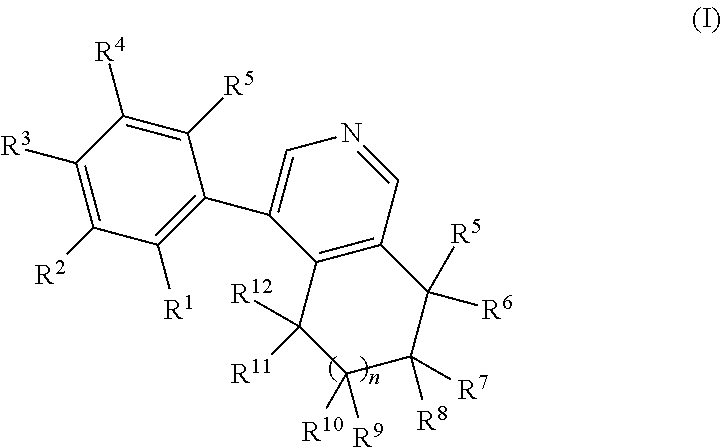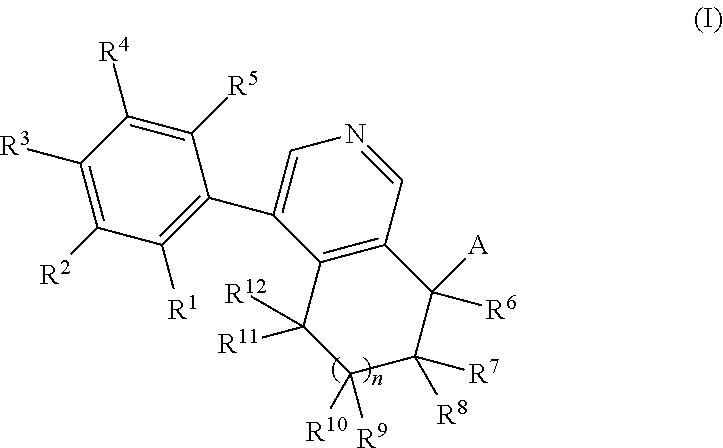Phenyl-tetrahydroisoquinoline derivatives
a technology of isoquinoline and phenyltetrahydroisoquinoline, which is applied in the field of organic compounds, can solve the problems of increased blood volume, increased blood pressure, and increased risk of other physiological complications of hypertensive subjects, and achieves the prevention of renal effects, improved blood pressure, cardiac and renal function, and increased pai-1 and osteopontin mrna expression
- Summary
- Abstract
- Description
- Claims
- Application Information
AI Technical Summary
Benefits of technology
Problems solved by technology
Method used
Image
Examples
example 1
(rac)-4-(8-Amino-5,6,7,8-tetrahydroisoquinolin-4-yl)benzonitrile
[0423]
[0424]In a 100 mL round-bottomed flask, (rac)-4-bromo-5,6,7,8-tetrahydroisoquinolin-8-amine (intermediate A-1[D]) (681 mg, 3 mmol) and 4-cyanophenylboronic acid (540 mg, 3.6 mmol) were dissolved in ethanol (54 mL) to give a light brown solution. Na2CO3 (350 mg, 3.3 mmol), dissolved in water (8.9 mL) was added followed by tetrakis(triphenylphosphine)palladium (0) (104 mg, 90 μmol) after evacuation and replacing 5 times with Argon. The solution was then heated at 85° C. overnight. The reaction was treated with an aq. 10% NaCl solution and extracted with AcOEt (3×). The organic phases were washed again with an aq. 10% NaCl solution, dried over Na2SO4, filtered and evaporated under reduced pressure to give 1.39 g brown foam which was purified by flash chromatography (50 g SiO2, Telos-cartridge, CH2Cl2 / MeOH (5 to 7.5%)) and precipitated from CH2Cl2 with n-pentane to give the title compound (605 mg, 81%) as a light brow...
example 2
(rac)-N-(4-(4-Cyanophenyl)-5,6,7,8-tetrahydroisoquinolin-8-yl)ethanesulfonamide
[0425]
[0426]A cooled (0° C.) solution of (rac)-4-(8-amino-5,6,7,8-tetrahydroisoquinolin-4-yl)benzonitrile (example 1) (62.3 mg, 250 μmol) in CH2Cl2 (3.6 ml) was treated with ethanesulfonyl chloride (26.6 μL, 275 μmol) and Et3N (41.8 μL, 300 μmol). After ½ h the mixture was stirred at room temperature for 3 h, cooled down (0° C.) and treated again with ethanesulfonyl chloride (7.3 μL, 75 μmol) and Et3N (11.5 μL, 82.5 μmol). After 2 h at room temperature, the mixture was concentrated in vacuo and purified by flash chromatography (20 g SiO2, Telos-cartridge, CH2Cl2 / MeOH (0.5 to 1.5%)) to give after precipitation from CH2Cl2 with n-pentane the pure title compound (43 mg, 50%) as a off-white powder. MS: 342.1 (M+H+).
example 3
(rac)-N-[4-(4-Cyanophenyl)-5,6,7,8-tetrahydroisoquinolin-8-yl]-N′-propylsulfuric diamide
[0427]
[0428]A cooled (0° C.) solution of (rac)-4-(8-amino-5,6,7,8-tetrahydroisoquinolin-4-yl)benzonitrile (example 1) (62.3 mg, 250 μmol) in CH2Cl2 (3 ml) was treated with propylsulfamoyl chloride (98.5 mg, 625 μmol) in CH2Cl2 (0.6 ml) and Et3N (69.7 μL, 500 μmol). After 1 h the mixture was stirred at room temperature for 1 h, cooled down (0° C.) and treated again with Et3N (69.7 μL, 500 μmol). After ½ h at room temperature, the mixture was treated with MeOH (0.2 mL) and extracted with water / AcOEt (3×). The organic phases were dried over Na2SO4, filtered and evaporated under reduced pressure. Purification by flash chromatography (50 g SiO2, Telos-cartridge, CH2Cl2 / MeOH (1 to 3%)) and precipitation from CH2Cl2 with n-pentane gave the title compound (63 mg, 68%) as off-white powder. MS: 371.2 (M+H+).
PUM
| Property | Measurement | Unit |
|---|---|---|
| Chemically inert | aaaaa | aaaaa |
Abstract
Description
Claims
Application Information
 Login to View More
Login to View More - R&D
- Intellectual Property
- Life Sciences
- Materials
- Tech Scout
- Unparalleled Data Quality
- Higher Quality Content
- 60% Fewer Hallucinations
Browse by: Latest US Patents, China's latest patents, Technical Efficacy Thesaurus, Application Domain, Technology Topic, Popular Technical Reports.
© 2025 PatSnap. All rights reserved.Legal|Privacy policy|Modern Slavery Act Transparency Statement|Sitemap|About US| Contact US: help@patsnap.com



